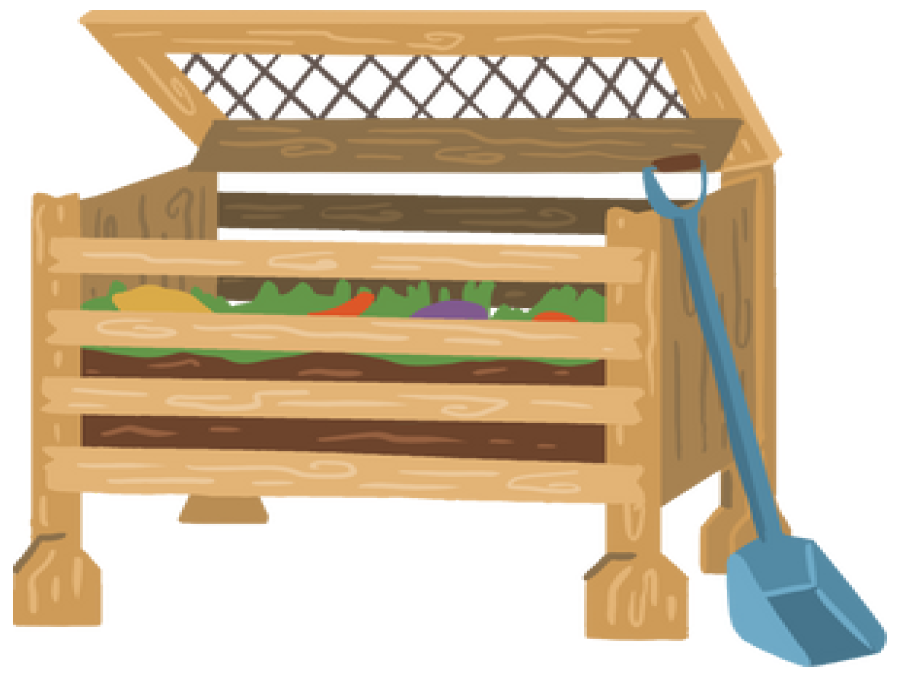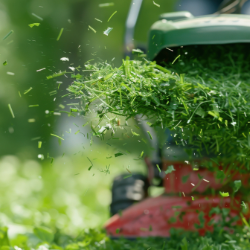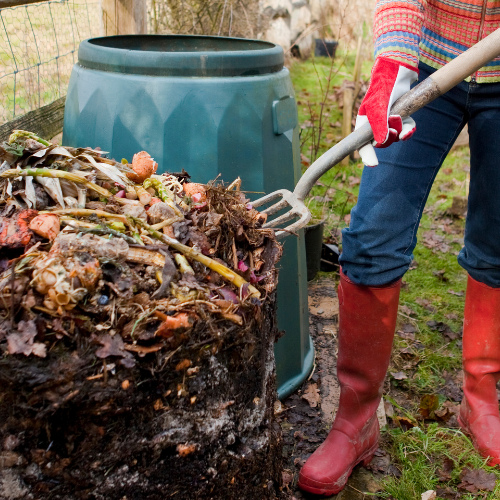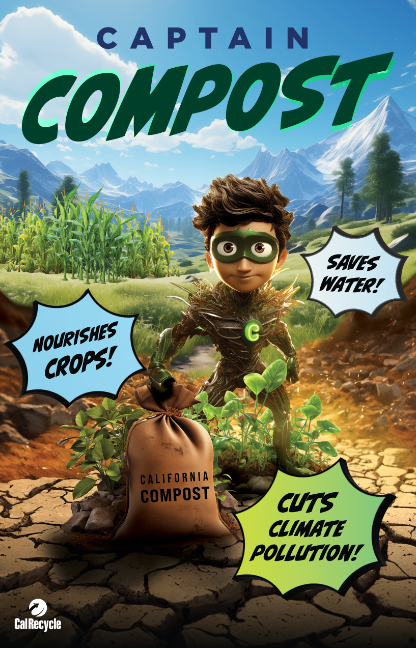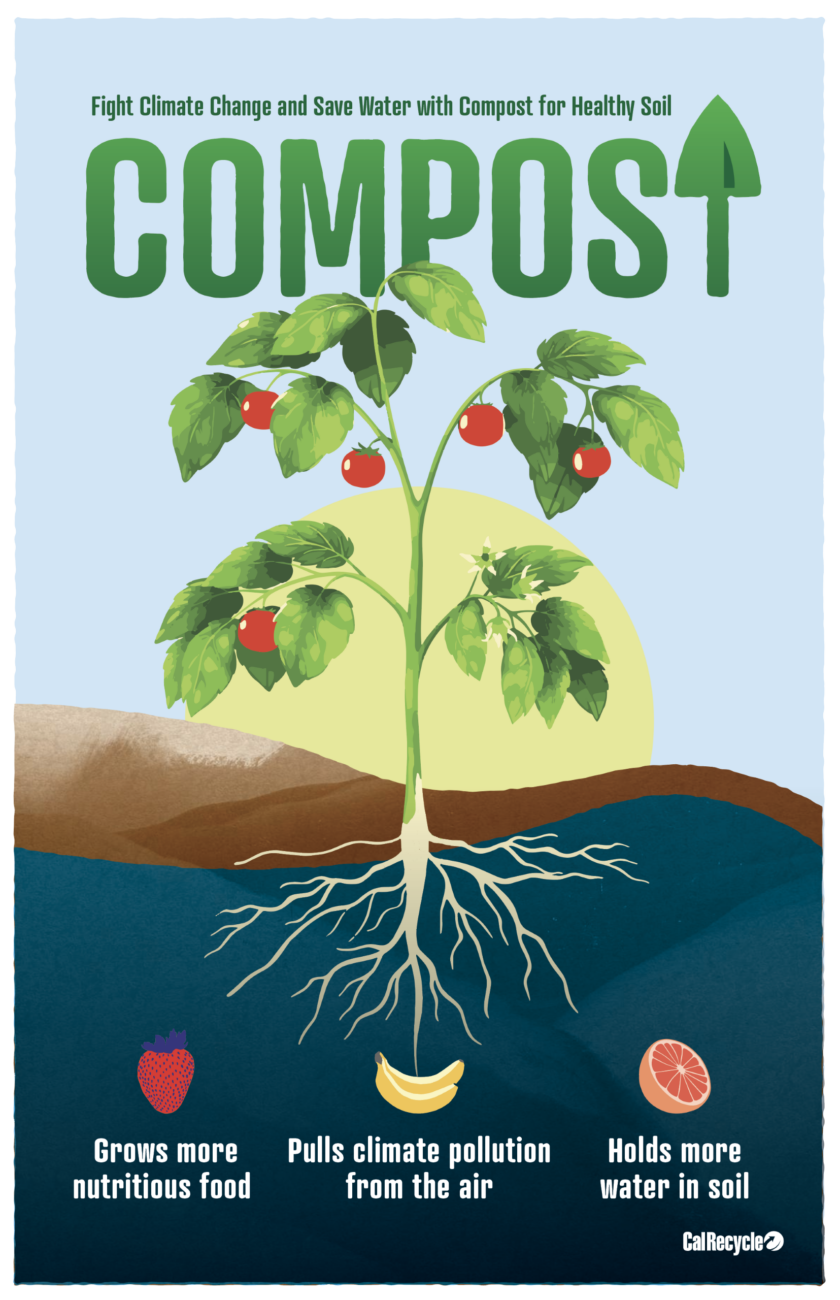Home Composting
Food scraps and yard waste breaking down in a compost pile with oxygen makes nutrient-rich compost, a superfood for plants.
Composting organic waste to use in your garden:
- Reduces trash sent to landfills.
- Cuts methane climate pollution from organic waste rotting in landfills.
- Provides nutrients that activate plants to pull more carbon pollution from the air.
- Improves soil health to sequester (store) carbon from the atmosphere.
Methane Pollution from Landfills Heats Our Climate
84 times more than carbon dioxide
(breaking down over 20 years)

Food and yard waste in landfills rots without oxygen, emitting methane pollution.


California’s climate crisis:
- Record-breaking heat.
- 7 of the 10 biggest fire years since 2007.
- Frequent droughts.
- Greatly depleted groundwater.
2 Ways Compost Fights Climate Change
Home systems can compost:
- Fruit and vegetable scraps.
- Tree and shrub trimmings.
- Fruit tree and vegetable waste.
- Lawn clippings.
- Leaves.
- Coffee grounds.
Do not compost meat, dairy, or a lot of baked goods in home compost.
This easy composting guide shares:
- How compost fights climate change.
- How compost helps your garden.
- How to select a bin and yard location.
- How to compost.
- Top fixes for compost issues.
50% of your water goes on your lawn
Fight Climate Change with Your Yard
Compost Videos
Greens (Nitrogen)
- Grass clippings.
- Landscape trimmings.
- Vegetable and fruit scraps.
- Coffee grounds and tea leaves.
Browns (Carbon)
- Dry leaves.
- Twigs.
- Hay.
- Untreated wood chips and sawdust.
Water
- Piles dry out easily.
- Piles need 40%-60% moisture.
- Add water weekly in hot months.
- During wet weather, cover your pile.
Air
- Good organisms need air to live.
- A pile too wet or compacted cuts off air, and these organisms die.
- Turn and fluff the pile weekly.
Size
Make pile at least 1 cubic yard – 3x3x3 ft to:
- Get it hot enough.
- Protect beneficial organisms.
Temperature
- Heat to >131°F to kill seeds and germs.
- Turn the pile to get all parts in the hot center.
- Use a compost thermometer with a long stem.
Time
- You’ll have finished compost in about:
- 3 months with close tending.
- 6 months to a year, if rarely tended.
You will know your compost is finished when:
- It stops heating up after you turn it.
- It’s as cool as the outside temperature.
- It no longer looks like what you added to the pile.
- Finished compost is dark, and crumbly with an earthy scent.
2 Types of Composting to Break Down Organics
- Hot composting: Uses heat and balance of nitrogen/carbon/air/water.
- Vermicomposting: Using worms in a bed of soil.
Troubleshooting a Home Composting Bin or Pile
| Pile Symptom | Problem(s) | Solution(s) |
|---|---|---|
| Smells bad | Not enough air OR too much moisture | Turn the pile if not enough air Add dry materials if too moist |
| Will not heat up | Not enough moisture OR Pile size is too small OR Lack of nitrogen-rich material OR Particle size is too big | Add water if dry Build pile to at least 3' x 3' x 3' Mix in grass clippings or fruit/vegetable scraps Chip or grind materials |
| Attracts flies, rodents, or pets | Pile contains bones, meat, fatty or starchy foods, or animal manure | Bury produce scraps in pile center or in 8-10 in. of soil. Enclose compost in a bin. Compost them in a worm bin. |
| Has slugs in it | Slugs can easily climb on pile. | Remove slugs and eggs from pile (look like small clusters of pearls). Locate compost pile far from vegetable gardens. Build barriers around pile/garden. |
Additional resources for Home Composting
For more information contact: Organic Materials, Organics@calrecycle.ca.gov

